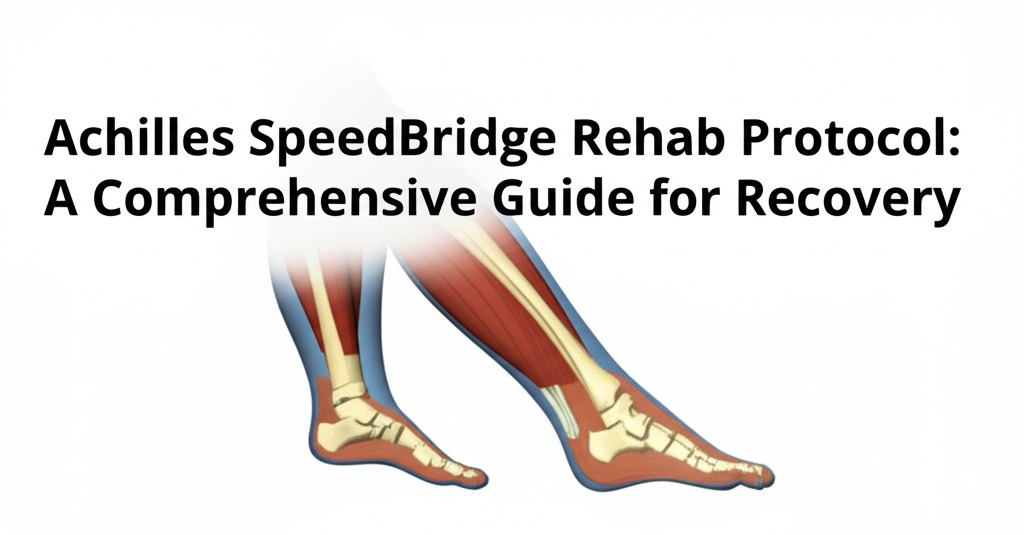Introduction
Achilles tendon injuries are among the most common ailments for athletes and active individuals, often resulting from overuse, improper footwear, or sudden physical stress. One of the most effective ways to rehabilitate a torn or strained Achilles tendon is through the Achilles SpeedBridge Rehab Protocol. This innovative protocol is designed to accelerate recovery while minimizing the risk of re-injury. In this article, we will dive deep into what the SpeedBridge protocol entails, how it works, and why it is highly regarded in rehabilitation circles.
What is the Achilles SpeedBridge Rehab Protocol?
The Achilles SpeedBridge Rehab Protocol is a scientifically backed rehabilitation program specifically aimed at treating Achilles tendon injuries. This approach is focused on progressive load management, functional movement, and early reloading to restore the strength and flexibility of the tendon while reducing pain and inflammation.
The protocol revolves around gradual yet effective exercises that help improve muscle activation and tendon healing. Developed for both athletes and non-athletes, it blends eccentric exercises, plyometrics, and strength training to target the Achilles tendon and surrounding structures.
Key Benefits of the Achilles SpeedBridge Rehab Protocol
The Achilles SpeedBridge Rehab Protocol offers several benefits, including:
- Faster Recovery: The protocol enables a quicker return to activity without sacrificing tendon health.
- Reduced Pain: By focusing on gradual loading, the protocol helps minimize pain and discomfort during the rehabilitation process.
- Injury Prevention: Strengthening the tendon and surrounding muscles reduces the risk of future injuries.
- Improved Functional Strength: By including both strength and mobility exercises, the protocol restores full functional capacity to the Achilles tendon.
Step-by-Step Breakdown of the Achilles SpeedBridge Rehab Protocol
Phase 1: Acute Phase – Pain Reduction and Inflammation Control
In the initial phase of the rehab protocol, the primary goal is to reduce pain and inflammation. This is typically done with rest, ice, and elevation, along with gentle, controlled stretching and mobility exercises. During this phase, it is essential to avoid activities that exacerbate pain, such as running or jumping.
Key Activities in Phase 1:
- Rest and Ice: Apply ice to the affected area to reduce inflammation.
- Gentle Stretching: Perform basic calf stretches to maintain flexibility.
- Isometric Exercises: Focus on holding static positions to engage the muscle without movement.
Phase 2: Subacute Phase – Strengthening the Tendon
Once the pain starts to subside, the rehab moves to strengthening the Achilles tendon through eccentric exercises. These exercises involve slowly lowering the body’s weight in a controlled manner, which has been shown to stimulate tendon healing and promote strength.
Key Exercises in Phase 2:
- Eccentric Heel Drops: Standing on a step, lower the heels below the level of the step, slowly and with control.
- Calf Raises: Perform slow, controlled calf raises with a focus on building strength in the tendon.
Phase 3: Progressive Loading – Restoring Function and Mobility
At this stage, the rehab protocol moves toward functional strengthening and plyometric exercises. These exercises simulate the movements required in sports and daily activities, helping the tendon regain its full capacity for explosive movements.
Key Exercises in Phase 3:
- Plyometric Jumps: Begin with low-intensity jump exercises, focusing on soft landings and controlled movements.
- Single-Leg Hops: Incorporate single-leg hops to work on balance and strength.
- SpeedBridge Activation: Perform dynamic movements like SpeedBridge exercises, which mimic the actions of sprinting or quick direction changes.
Phase 4: Return to Sport or Activity
In the final phase of the rehab protocol, the focus is on returning to sport-specific movements and activities. At this stage, the Achilles tendon should be fully healed, strong, and flexible. Gradually reintroduce higher-intensity workouts, while continuing to monitor for any signs of discomfort or re-injury.
Key Activities in Phase 4:
- Sport-Specific Drills: Start with low-intensity sport-specific drills, such as light running or agility drills.
- High-Intensity Plyometrics: Incorporate more intense plyometric exercises to enhance explosiveness.
How the SpeedBridge Rehab Protocol Stands Out
What makes the Achilles SpeedBridge Rehab Protocol so effective is its emphasis on early loading and functional movements. Unlike traditional protocols that emphasize rest and passive healing, the SpeedBridge method encourages gradual, controlled reloading of the tendon. This helps stimulate the healing process and rebuild strength faster.
The inclusion of dynamic exercises and plyometrics ensures that the tendon doesn’t just heal in isolation but is integrated back into full movement patterns. This protocol can be adjusted based on the severity of the injury and the patient’s unique progress.
Tips for Success During Achilles Rehab
- Stay Consistent: Regularly perform the exercises as prescribed in the protocol. Consistency is key to success.
- Listen to Your Body: If you experience pain or discomfort during exercises, take a step back and consult a professional.
- Use Proper Form: Correct form during exercises is crucial for effectiveness and to avoid further injury.
- Gradually Increase Intensity: Avoid rushing into high-intensity movements too quickly. Focus on progression.
Conclusion
Recovering from an Achilles tendon injury can be a long and frustrating process, but with the Achilles SpeedBridge Rehab Protocol, you have a clear path toward full recovery. By following the progressive stages of loading, strengthening, and restoring mobility, you can return to your sport or activities stronger than before.
Remember, consistency, patience, and proper guidance are essential to the success of any rehab protocol. If you’re dealing with an Achilles injury, consult with a medical professional to ensure this protocol is suitable for your situation, and start working your way back to full health!

Kallie Snyder is an author at Stonegate Health Rehab, providing valuable insights, recovery guidance, and rehab resources to help individuals achieve better health and well-being.
